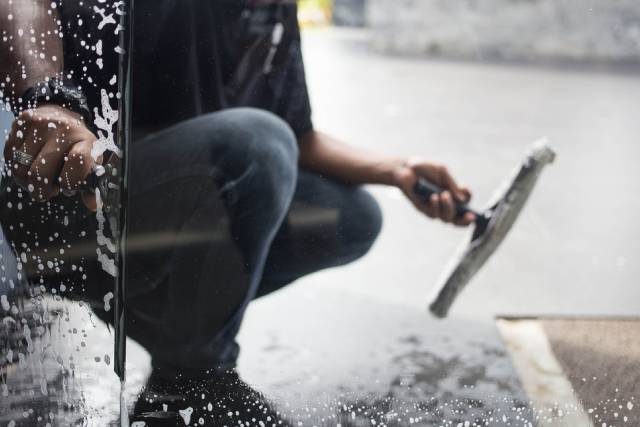Mastering Window Cleaning: Effective Techniques Unveiled
POSTED ON July 24, 2023
Mastering the right techniques is key to keeping your windows looking clean and sparkling.
Window cleaning can be daunting, but with the right approach, you can ensure your windows always look spotless. In this blog post, we'll unveil effective window cleaning techniques to help you keep your windows in tip-top shape year-round.
We'll cover everything from understanding the basics of window cleaning to choosing the right solutions and unique techniques for different types of windows. Plus, we'll provide tips on how to maintain them between cleanings. No matter what type of windows you have or how much time you have, follow these strategies to keep them clean all year. If you don't have time to do it yourself, remember that booking a professional window cleaning service is also an option!

Understanding the Window Cleaning Basics
Mastering window cleaning begins with understanding the basics. There is an essential difference between cleaning windows from the inside only and cleaning those from both sides. Based on the cleaning type and windows you have determine what materials will be most suitable.
Learning the most effective techniques based on your situation will allow you to keep your windows looking spotless all year. Let's look at some key points to consider regarding mastering window cleaning.
Our Window Cleaning Service Expert at Paul's Cleaning Sydney - Kelly shares a tried and proven method to achieve spotless windows: use a mixture of vinegar and warm water. The acidic properties of the solution quickly break down dirt, resulting in streak-free and shiny windows.
For the best results, follow these steps to achieve clean and sparkling windows:
1. Wipe the window frame and glass with a sponge and warm water to remove dust and dirt.
2.Use the homemade solution of vinegar and warm water. You can apply it with paper towels or use a squeegee if comfortable.
3.Start cleaning from the inside and work your way out. This way, you'll be able to spot any leftover debris easily.
4. Place a towel on the floor when cleaning the windows from inside to protect your carpet or wooden flooring.
The most effective materials for window cleaning vary based on the type of windows you are working with:
How To Prevent Streaks?
Using distilled water will reduce streaks. Avoid cleaning your windows when the sun is shining too hot because the window cleaning solution will dry too quickly before you can clean the glass. You can prevent streaks on your windows caused by dripping squeegees by wiping the blade off regularly with a cloth. Or you can replace the blade every few months. With these tips in mind, you'll have no trouble keeping your windows sparkling clean all year round!
Choose The Right Solution
Choosing the proper cleaning solution is essential. After all, your windows have their specific needs, according to the material they are made of. With that said, there are several components and features to consider when selecting a window cleaner for your home or business.
The first thing to consider is the type of window you will be cleaning. Different types of windows might need specialised cleaners; for instance, if you have aluminium or vinyl windows, you'll need a cleaner produced explicitly for those materials. If you have glass windows, there are many specialised glass-cleaning solutions available.
Please read the label carefully and choose the product suitable for your window type based on the ingredients label. For example, most over-the-counter products for window cleaning seem to have ammonia, which we recommend you steer away from if you have tinted windows.
Why not choose a glass cleaner that is non-toxic and eco-friendly? If you think green and want to be sustainable because you care about nature, look for an enzyme-based window cleaner. It is organic and contains enzymes that break down dirt and grease, leaving the glass streak-free.
In most cases, window cleaners are ready-to-use solutions. However, if you use a concentrated window cleaning solution, mix it according to the package instructions before applying it. Over-applying a concentrated solution can cause spotting or streaking on glass surfaces. When handling chemical cleaners, you should always wear protective gear (such as gloves) to avoid skin irritation or contact dermatitis.
Finally, if you'd like an even more economical option than store-bought products, you could make your window cleaner. It's an easy task that requires just white vinegar mixed with warm water in equal parts – spray onto the surface of the window and wipe clean with a lint-free cloth or paper towel! Of course, this method isn't ideal for more demanding jobs such as removing stubborn dirt from the outer side of the windows, but it works great as an everyday solution indoors!
Choosing the proper cleaning solution is key to getting sparkling clean windows without damaging them in any way - so take time researching different products until you find one that meets all your needs!
Step By Step Guide For Windows Cleaning
This section provides a step-by-step guide to mastering window cleaning. It is important to properly prepare the area and supplies before starting any project, especially for window cleaning. Before beginning, it is important to ensure the windows are closed, and no screens are in the way. The best conditions for cleaning windows are during cool and cloudy days when it is not raining.
The supplies needed for effective window cleaning are a bucket, a microfiber applicator (works best), a good quality squeegee, microfiber cloths or paper towels, a ladder (if necessary) and the window cleaning solution we chose in the previous step.
Once you have gathered all of the supplies, it is time to start cleaning!
- 1. Remove any cobwebs around the frames.
- 2. Prepare the window cleaning solution according to the instructions on the bottle.
- 3.Use a damp cloth or sponge to break down the dirt and wipe the frame and glass from the excess dust. It will help you prevent dirt from splashing onto other surfaces while cleaning. Remember the tracks. Let's go ahead and clean the glass.
- 4. Use an applicator pad or cloth with your selected cleaning solution to wipe down each windowpane from both sides: from top to bottom—in straight horizontal or vertical strokes.
- 5. Squeegee comes next for streak-free results: Start at the top of each windowpane and pull down continuously until you reach the bottom.
- 6. Wipe any excess water with a lint-free cloth or paper towel after each swipe until all the windows are clean.
- 7. If you notice any stubborn streaks after using the squeegee, touch up with an ammonia-based solution or if unsuitable, use white vinegar diluted in water, and go over the streaks with a lint-free cloth or paper towels. Scrub lightly in circular motions until all the streaks disappear.
- 8. For the hard-to-reach windows on higher floors, always make sure you have someone present who can spot you while you work from above ground level; alternatively, invest in additional accessories such as extension poles, which allow you to access higher levels safely from below ground level without having anyone else present when needed.
- 9. For the hard-to-reach windows on higher floors, always make sure you have someone present who can spot you while you work from above ground level; alternatively, invest in additional accessories such as extension poles, which allow you to access higher levels safely from below ground level without having anyone else present when needed.
- 10. Finally, ensure all windows are opened slightly post-cleaning so they can air dry naturally instead of leaving them open wide, which could cause draughts throughout your home.
With this comprehensive step-by-step guide, readers will learn to keep their windows sparkling clean!
Techniques Tailored to Specific Window Styles
From single-paned to multi-panelled windows, window cleaning can be a simple process. However, taking the necessary precautions with difficult access windows such as skylights and second-story windows is important. In these situations, the best practice overall in cleaning is having someone spot you while you are working on heights for safety reasons.
Additionally, protective gear such as goggles should always be worn in case any debris falls your way during the cleaning process. By following these tips and using the proper technique for each type of window, anyone can achieve great results without worrying about potential danger!.
Maintaining Your Windows Between Cleanings
Maintaining your windows between cleanings is the key to keeping them looking sparkling clean all year round. By following simple steps, you can ensure that your windows remain in top condition with minimal effort.
The first step is thoroughly cleaning both sides of your windowpanes during your regular cleaning routine. Including it in your cleaning regime will help prevent dirt from building up and keep the glass streak-free for longer. Also, it's essential to check the seals around the window frame and reseal any cracked or worn-out. Fixing the seals will prevent air from seeping in and decrease the chances of dealing with water damage on walls and frames caused by condensation buildup.
Additionally, inspecting your window frames and casings for signs of mould or other damage is important. It's best to take immediate action if you notice any issues, as this could lead to costly repairs. Lastly, trim the plants growing close to your windows regularly so they don't interfere with light coming in or block the view outside.
By following these simple tips, you will be on top of things with maintaining your windows squeaky clean.
We recommend you clean your windows in and out twice a year. The most suitable seasons are spring and fall, as, during that time of the year, you have cool, cloudy days, which are best for cleaning the windows streak-free.
Ready to give your windows a professional touch? Book our cleaning service today and let our experienced team make your windows sparkle!





